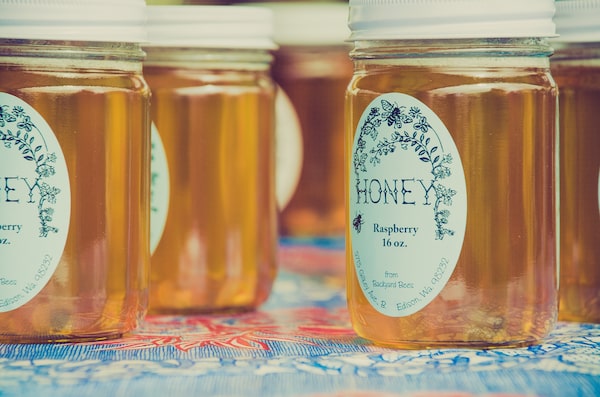
A variety of honeys on display.
Honey plays a large role in the Jewish New Year, celebrated Sept. 9 this year. The symbolic dipping of apples into honey represents hope for a sweet and fruitful year, and dessert is often a moist, rich honey cake.
Honey has been around for thousands of years and was originally used as a sweetener and for its anti-bacterial properties. It is now considered a mild antiseptic and some people swear by its allergy-attacking properties, saying it can be used to soothe reactions and relieve watering eyes. At one time, honey was fermented into alcoholic mead, which is making a return to our tables today, being produced in both Ontario and British Columbia.
Honey has the same properties as sugar, but it is more suitable in some recipes since it is a liquid. Judiciously using honey in savoury dishes produces a sweet burst of energy, smooths out edges and heightens flavours. Moroccan and Middle Eastern cooking uses honey alongside dried fruits and spices in tagines and long-simmered stews. It also balances flavours in salad dressing, and a little in a glaze will give a succulent look to your meat.
If you heat honey for a recipe, do it very gently on top of the stove as it can caramelize quickly and lose its flavour.
To substitute honey in baking, use ¾ cup honey for every 1 cup sugar. Cut back the liquid by 2 tablespoons and cook at a temperature 25 degrees lower than specified.
There is a lot of adulterated honey around, usually with the addition of high-fructose corn syrup, so best to check labels – even better, buy local. And don’t refrigerate honey. If it becomes a little granular, heat it slightly. I find a 20-second microwave blast solves the problem.
Honey tastes of the flowers that the bees pollinated. Wildflower, buckwheat, lavender – the flavours are almost endless. Some honey is so local it might be named after your neighbourhood. Urban beekeeping company Alveole has boxed sets of four Toronto honeys with flavours ranging from Rosedale to the Junction, for instance.
There is, however, a sadder side to this sweet stuff, as honey bees are being killed off by insecticides. If we lose the pollinators, we lose vegetables and flowers. Canada has banned the worst insecticides, but it will be three to five years before they are completely phased out.
Because beekeeping has made such a comeback, there are hives all over Toronto and in other major cities. CBC’s Toronto headquarters, the Fairmont Royal York hotel and many rooftops and balconies are hosting hives – and so can you. Across Canada, there are organizations that are making it attractive to help produce local honey. You can adopt a hive, share a hive or help those doing it already by buying honey at local markets. Get in touch with, among other companies, Alveole (alveole.buzz) in Ontario and Quebec for more information, and eastvanbees.com on the West Coast.
Need some advice about kitchen life and entertaining? Send your questions to lwaverman@globeandmail.com.